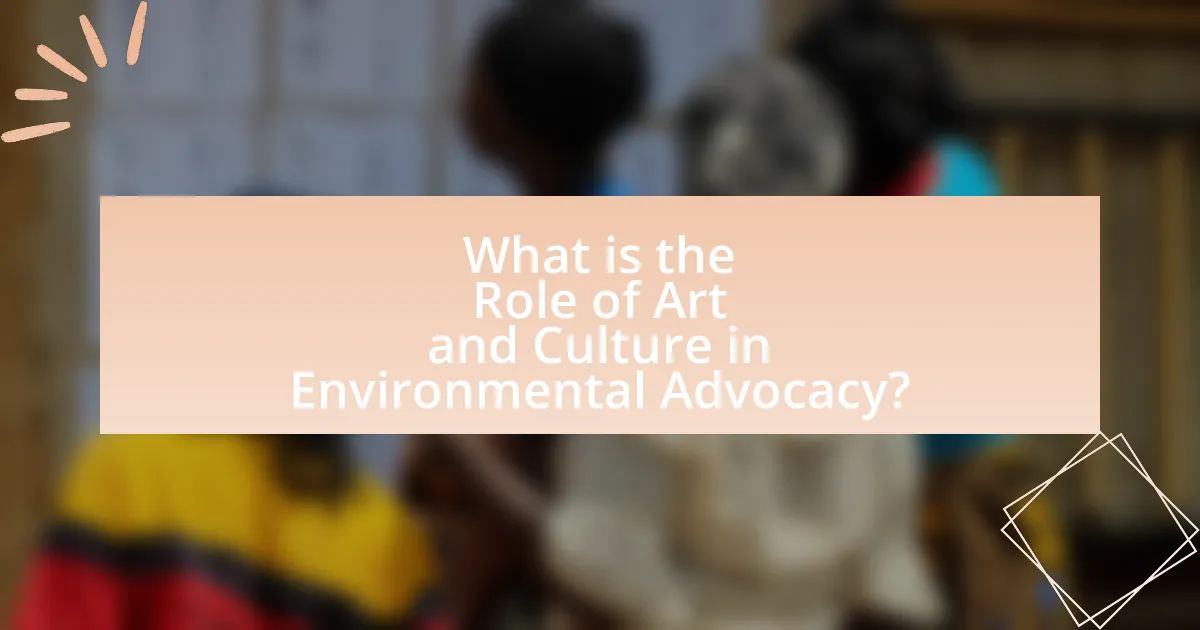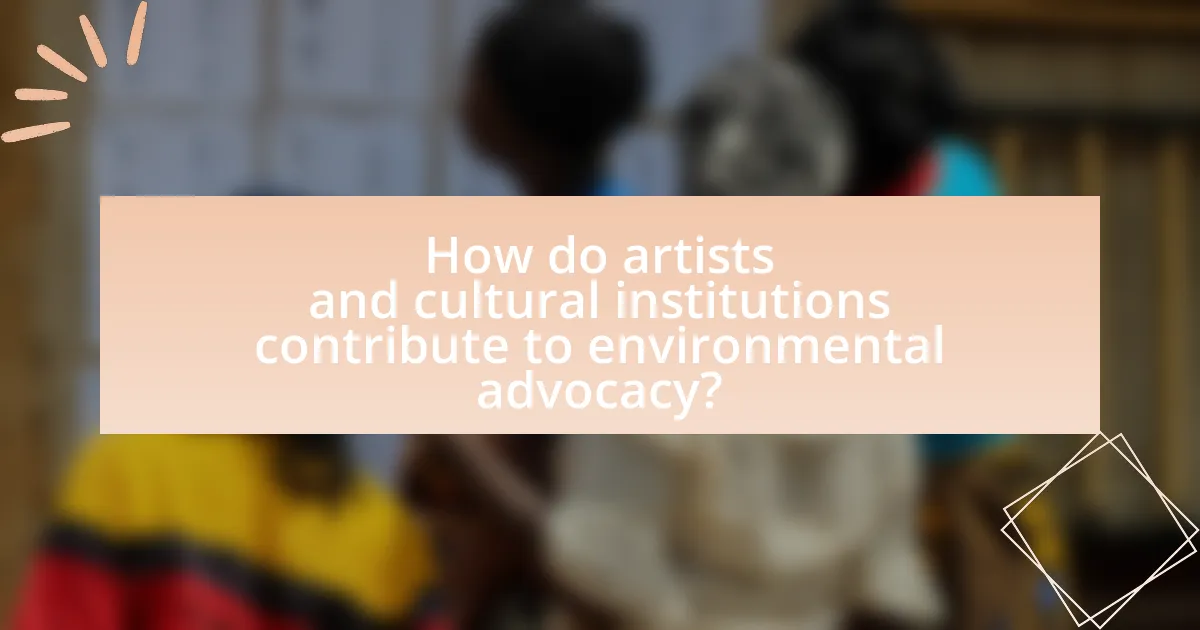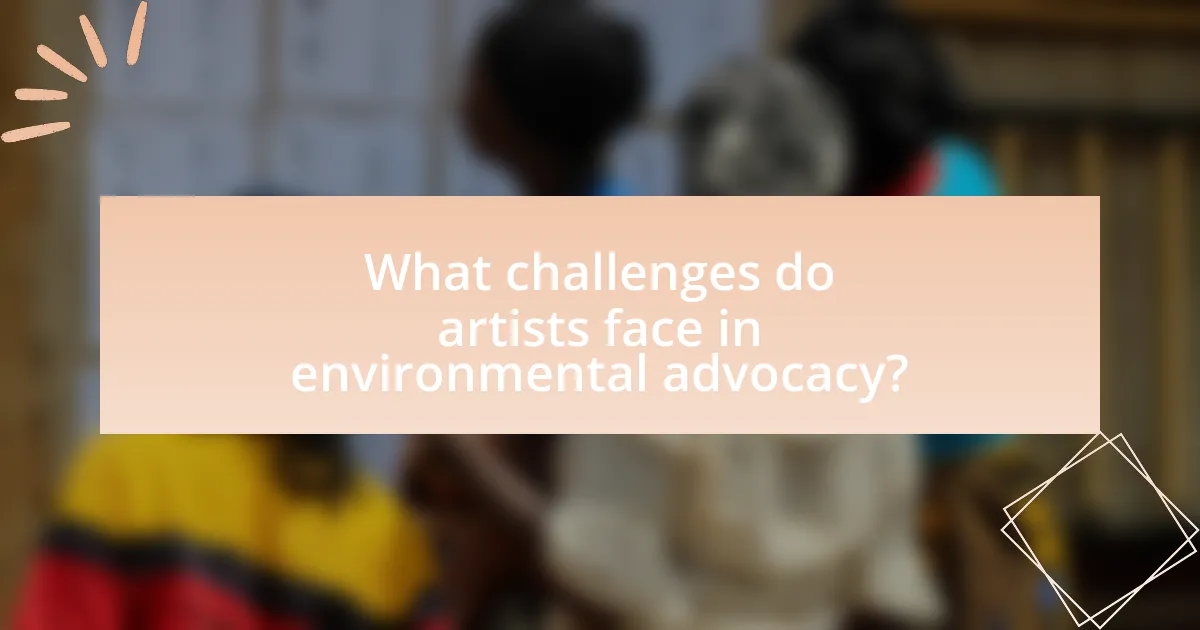The article examines the significant role of art and culture in environmental advocacy, highlighting how various artistic expressions raise awareness, inspire action, and foster community engagement regarding ecological issues. It discusses the influence of art on public perception, the effectiveness of different art forms in conveying environmental messages, and the importance of cultural representation in advocacy efforts. Additionally, the article explores the challenges artists face in addressing environmental topics, strategies for collaboration with scientists and activists, and best practices for integrating art into environmental initiatives. It emphasizes the need for community support and available resources for artists committed to promoting environmental awareness through their work.

What is the Role of Art and Culture in Environmental Advocacy?
Art and culture play a crucial role in environmental advocacy by raising awareness, inspiring action, and fostering community engagement. Through various forms of expression, such as visual arts, music, and literature, artists can communicate complex environmental issues in relatable and impactful ways. For instance, the “Earth Day” movement has utilized art installations to highlight climate change, effectively reaching diverse audiences and prompting discussions. Additionally, cultural narratives and storytelling can shape public perception and motivate individuals to participate in environmental initiatives, as seen in campaigns like “Fridays for Future,” which combines art with activism to mobilize youth globally.
How does art influence public perception of environmental issues?
Art significantly influences public perception of environmental issues by evoking emotional responses and raising awareness through visual storytelling. For instance, impactful artworks, such as those by artists like Olafur Eliasson, often highlight climate change and biodiversity loss, prompting viewers to reflect on their relationship with nature. Research indicates that art can enhance understanding and engagement with environmental topics; a study published in the journal “Environmental Communication” found that art installations can effectively communicate complex environmental issues, making them more relatable and urgent to the public. This emotional engagement can lead to increased advocacy and behavioral change regarding environmental protection.
What types of art are most effective in conveying environmental messages?
Visual art, particularly installations and murals, is most effective in conveying environmental messages. These forms of art engage viewers through immersive experiences and large-scale visuals that can evoke emotional responses. For instance, the “The Ocean Cleanup” project uses art installations to raise awareness about ocean pollution, effectively combining aesthetics with a powerful environmental message. Additionally, performance art, such as theater and dance, can dramatize environmental issues, making them relatable and urgent. Research indicates that visual and performance arts can significantly enhance public engagement and understanding of environmental challenges, as evidenced by studies showing increased awareness and behavioral change among audiences exposed to such art forms.
How do cultural narratives shape environmental advocacy through art?
Cultural narratives shape environmental advocacy through art by providing relatable stories that resonate with audiences, fostering emotional connections to environmental issues. For instance, indigenous art often reflects a deep relationship with nature, highlighting the importance of conservation and sustainability. This connection can mobilize communities and influence public policy, as seen in campaigns that utilize visual storytelling to raise awareness about climate change. Research indicates that art can effectively communicate complex environmental concepts, making them accessible and engaging, thus driving advocacy efforts.
Why is cultural representation important in environmental advocacy?
Cultural representation is important in environmental advocacy because it ensures diverse voices and perspectives are included in discussions about environmental issues. This inclusivity fosters a deeper understanding of how different communities are affected by environmental changes and policies. For instance, Indigenous communities often possess unique knowledge about local ecosystems, which can enhance conservation efforts. Studies, such as those published in the journal “Environmental Science & Policy,” demonstrate that incorporating cultural narratives can lead to more effective and equitable environmental solutions. By recognizing and valuing cultural representation, advocacy efforts can become more relatable and impactful, ultimately driving broader public engagement and support for environmental initiatives.
How do different cultures approach environmental issues through art?
Different cultures approach environmental issues through art by utilizing various artistic expressions to raise awareness, convey messages, and inspire action regarding ecological concerns. For instance, Indigenous cultures often incorporate traditional storytelling and visual arts to highlight the relationship between nature and community, emphasizing sustainability and respect for the environment. In contrast, contemporary urban cultures may use street art and installations to critique industrialization and advocate for climate action, as seen in the works of artists like Banksy, who addresses environmental degradation through provocative imagery. Furthermore, global initiatives like the “Earth Day Art Contest” encourage artists from diverse backgrounds to create works that reflect their cultural perspectives on environmental issues, fostering a collective dialogue. These artistic approaches not only reflect cultural values but also serve as powerful tools for environmental advocacy, engaging audiences and prompting societal change.
What role do indigenous cultures play in environmental advocacy through art?
Indigenous cultures play a crucial role in environmental advocacy through art by using their traditional practices and storytelling to highlight the importance of nature and sustainability. This artistic expression often reflects deep spiritual connections to the land, which can raise awareness about environmental issues and promote conservation efforts. For example, Indigenous artists frequently incorporate themes of biodiversity and ecological balance in their works, which serve as powerful visual narratives that educate the public about the impacts of climate change and habitat destruction. Studies have shown that art created by Indigenous communities can effectively mobilize support for environmental causes, as it resonates emotionally with audiences and fosters a sense of responsibility towards the environment.

How do artists and cultural institutions contribute to environmental advocacy?
Artists and cultural institutions contribute to environmental advocacy by raising awareness and inspiring action through creative expression. They utilize various mediums, such as visual arts, music, and performance, to communicate urgent environmental issues, making complex topics more accessible and engaging to the public. For instance, the “Art for the Earth” initiative showcases artworks that highlight climate change, effectively reaching diverse audiences and prompting discussions about sustainability. Additionally, cultural institutions often host exhibitions and events focused on environmental themes, such as the “Nature and the Arts” exhibition at the Smithsonian, which emphasizes the interconnectedness of art and nature. These efforts not only educate the public but also mobilize communities to participate in environmental protection initiatives, demonstrating the significant impact of art and culture on environmental advocacy.
What initiatives have artists taken to promote environmental awareness?
Artists have initiated various projects to promote environmental awareness, including public art installations, eco-friendly exhibitions, and community engagement programs. For instance, the “Ocean Cleanup” project, led by artist Boyan Slat, combines art and technology to address ocean pollution, showcasing the impact of plastic waste on marine life. Additionally, the “Art for the Earth” initiative encourages artists to create works that reflect environmental themes, raising funds for conservation efforts. These initiatives not only raise awareness but also inspire action towards sustainability, demonstrating the powerful role of art in environmental advocacy.
How do collaborative projects between artists and environmental organizations work?
Collaborative projects between artists and environmental organizations work by combining artistic expression with environmental advocacy to raise awareness and inspire action. Artists create works that reflect environmental issues, while organizations provide context, resources, and platforms for outreach. For example, the “Art for the Earth” initiative pairs visual artists with conservation groups to produce installations that highlight climate change impacts, effectively engaging the public. This collaboration not only amplifies the message of environmental organizations but also allows artists to contribute meaningfully to social change, as evidenced by projects like the “Ocean Plastic Art” campaign, which uses art to address ocean pollution and has garnered significant media attention and public engagement.
What impact do art exhibitions focused on environmental themes have?
Art exhibitions focused on environmental themes significantly raise awareness about ecological issues and inspire action among viewers. These exhibitions often utilize visual storytelling to convey the urgency of environmental challenges, effectively engaging audiences emotionally and intellectually. For instance, a study by the University of California, Berkeley, found that visitors to environmental art exhibitions reported increased concern for climate change and a greater likelihood of participating in sustainability initiatives. This demonstrates that art can serve as a powerful catalyst for environmental advocacy, influencing public perception and behavior towards ecological preservation.
How do cultural events raise awareness about environmental issues?
Cultural events raise awareness about environmental issues by engaging communities through artistic expression and shared experiences. These events often incorporate themes related to sustainability, conservation, and climate change, effectively communicating complex environmental messages in accessible formats. For instance, festivals, art exhibitions, and performances can highlight the impact of pollution or deforestation, prompting attendees to reflect on their environmental footprint. Research indicates that participatory art projects, such as community murals focused on local ecosystems, can increase public understanding and concern for environmental issues, as demonstrated in studies by the University of California, which found that such initiatives significantly enhance community engagement and awareness.
What types of cultural events are most effective in engaging communities?
Cultural events that effectively engage communities include festivals, workshops, and art exhibitions focused on environmental themes. These events foster participation and dialogue, allowing community members to connect with each other and the issues at hand. For instance, community festivals that incorporate local artists and environmental education can attract diverse audiences, as evidenced by the success of events like the Earth Day Festival, which draws thousands of participants annually and raises awareness about sustainability. Workshops that involve hands-on activities, such as community gardening or art-making from recycled materials, also promote engagement by providing practical skills and fostering a sense of ownership over local environmental issues.
How can festivals and performances serve as platforms for environmental advocacy?
Festivals and performances can serve as platforms for environmental advocacy by raising awareness, engaging communities, and promoting sustainable practices. These events often attract large audiences, providing a unique opportunity to disseminate information about environmental issues through art, music, and interactive experiences. For instance, the 2019 Earth Day Festival in Washington, D.C., featured performances that highlighted climate change, drawing attention to the urgency of environmental action. Additionally, festivals can incorporate eco-friendly practices, such as waste reduction and renewable energy use, setting an example for attendees. Research shows that cultural events can significantly influence public attitudes towards environmental issues, as demonstrated by a study published in the Journal of Environmental Psychology, which found that participation in arts-based initiatives increased individuals’ environmental concern and pro-environmental behaviors.

What challenges do artists face in environmental advocacy?
Artists face several challenges in environmental advocacy, primarily including funding limitations, audience engagement, and the complexity of environmental issues. Funding limitations restrict artists’ ability to create impactful works that address environmental concerns, as many rely on grants or sponsorships that may not prioritize environmental themes. Audience engagement poses a challenge because conveying complex environmental issues through art requires not only creativity but also the ability to connect with diverse audiences, which can be difficult. Additionally, the complexity of environmental issues often leads to oversimplification in artistic representations, risking the dilution of critical messages. These challenges hinder artists’ effectiveness in raising awareness and driving action on environmental issues.
How does funding affect artistic projects focused on environmental issues?
Funding significantly influences artistic projects focused on environmental issues by determining the scope, reach, and impact of these initiatives. Adequate financial resources enable artists to create high-quality work, engage in extensive research, and collaborate with experts, thereby enhancing the project’s credibility and effectiveness. For instance, projects like “The Ocean Cleanup,” which received substantial funding, have successfully developed innovative solutions to plastic pollution, demonstrating how financial support can lead to tangible environmental benefits. Conversely, limited funding can restrict artistic expression and outreach, resulting in less impactful projects that fail to engage broader audiences or drive meaningful change.
What barriers do artists encounter when addressing controversial environmental topics?
Artists encounter several barriers when addressing controversial environmental topics, including censorship, public backlash, and funding limitations. Censorship often arises from political or corporate interests that may oppose the messages conveyed through art, leading to restrictions on artistic expression. Public backlash can occur when audiences disagree with the artist’s perspective, resulting in negative reactions that discourage further exploration of the topic. Additionally, funding limitations can hinder artists’ ability to create and promote their work, as sponsors may shy away from supporting projects that tackle contentious issues. These barriers collectively impede artists’ efforts to engage in meaningful dialogue about environmental concerns.
What strategies can artists use to overcome these challenges?
Artists can overcome challenges in environmental advocacy by employing strategies such as collaboration, community engagement, and utilizing digital platforms. Collaboration with environmental organizations allows artists to align their creative efforts with scientific data, enhancing the impact of their messages. Community engagement fosters a deeper connection with audiences, enabling artists to create works that resonate with local environmental issues. Utilizing digital platforms expands reach and accessibility, allowing artists to share their work with a global audience, as evidenced by campaigns like #ArtForTheEarth, which mobilized artists worldwide to raise awareness about climate change. These strategies not only amplify the artists’ voices but also contribute to a collective movement towards environmental awareness and action.
How can artists collaborate with scientists and activists for greater impact?
Artists can collaborate with scientists and activists by creating interdisciplinary projects that merge artistic expression with scientific research and social activism. This collaboration can take the form of public art installations that raise awareness about environmental issues, such as climate change or biodiversity loss, effectively communicating complex scientific concepts to a broader audience. For instance, the “Ice Watch” project, where artists and scientists worked together to display large blocks of ice in urban settings, visually demonstrated the impacts of global warming, engaging the public in a dialogue about climate change. Such partnerships leverage the emotional power of art to complement the factual basis of science, enhancing the overall impact of advocacy efforts.
What role does social media play in promoting art for environmental advocacy?
Social media serves as a crucial platform for promoting art that advocates for environmental issues by amplifying visibility and engagement. Artists utilize social media to share their work, connect with audiences, and raise awareness about environmental challenges, effectively reaching millions globally. For instance, campaigns like #ArtForEarth leverage platforms such as Instagram and Twitter to showcase eco-themed artworks, fostering community discussions and inspiring action. Research indicates that visual content on social media can increase engagement rates by up to 650%, demonstrating its effectiveness in mobilizing support for environmental causes through artistic expression.
What are best practices for integrating art and culture into environmental advocacy?
Best practices for integrating art and culture into environmental advocacy include collaborating with local artists to create impactful visual narratives that resonate with communities. Engaging in community-based art projects fosters a sense of ownership and connection to environmental issues, as seen in initiatives like the “Art for the Earth” project, which successfully raised awareness about climate change through public murals. Additionally, utilizing performance art and storytelling can effectively convey complex environmental messages, as demonstrated by the “Theater of the Oppressed” techniques that empower marginalized voices in environmental discussions. Incorporating cultural traditions and practices into advocacy efforts can also enhance relevance and relatability, as evidenced by Indigenous-led movements that blend cultural heritage with environmental stewardship.
How can communities effectively support local artists in environmental initiatives?
Communities can effectively support local artists in environmental initiatives by providing funding, resources, and platforms for collaboration. For instance, local governments and organizations can establish grants specifically for artists working on environmental projects, which can enhance the visibility and impact of their work. According to a report by the National Endowment for the Arts, public funding for the arts can lead to increased community engagement and awareness around environmental issues. Additionally, communities can create partnerships between artists and environmental organizations, facilitating projects that merge artistic expression with ecological advocacy, thereby amplifying the message and reach of both parties.
What resources are available for artists interested in environmental advocacy?
Artists interested in environmental advocacy can access various resources, including grants, organizations, and platforms dedicated to supporting eco-conscious art. Notable organizations such as the Creative Capital Foundation provide funding and professional development for artists engaged in social issues, including environmental concerns. Additionally, the Art for the Earth initiative connects artists with environmental organizations to promote awareness and action through art. Resources like the EcoArt Network offer a community and information for artists focused on ecological themes, while platforms like Instagram and ArtStation allow artists to showcase their work and connect with like-minded individuals. These resources collectively empower artists to contribute meaningfully to environmental advocacy through their creative practices.